
When Ferrari decided that a road-going car should be used on track, a number would be set aside to receive lightweight coachwork – yet only nine Californias were ever bodied in alloy. Of these, several were of comparatively ordinary specification and a few never fulfilled their destinies. Some were campaigned with publicity in mind and, after one or two events, were sold to customers and became road cars. Several did make waves, generally in the country that proved to be the largest market for the California – the US.
While all of the Californias that raced hold special significance, only three achieved great success and notoriety. The car featured here is certainly among this rarified breed and is widely regarded as the ultimate LWB California Competizione.
If only for its mechanical specification, 1603 GT should be considered a standout.
Completed on November 23, 1959, it was one of the last 10 LWB Californias produced, and thus benefited from a highly developed foundation, the 508D chassis with all the improvements of the early 250s.
As usual, the next point of focus for Ferrari was the engine and this car was specified with a very special competition unit tuned to an unusually high level of performance. It was, in essence, an outside-plug Tipo 168 engine as used in the competition Berlinettas – a type of engine fitted to only one other California – an alloy SWB with Le Mans history.
The block was equipped with the legendary high-performance 130 camshafts with 10 mm of lift, 40 DCL 6 
To handle the extra power, a ribbed alloy 508C gearbox was installed and, as it was designed for the long-distance endurance events, the California was equipped with an oversized fuel tank capable of storing 136 liters, accessed through a competition-type outside filler cap exiting through the trunk lid. Most notably, 1603 GT was the first California Spider to be equipped with disc brakes, a feature that truly sets this car apart and one that adds a great deal to its overall performance.
The gorgeous all-aluminum Scaglietti body was finished in a distinctive silver gray metallic with polished side louvres and the desirable covered headlamps that do so much for the crisp, taut lines of the coachwork. As completed, 1603 GT was entirely unique in its combination of mechanical and cosmetic details.
The Spider Competizione was imported by Luigi Chinetti, the most significant proponent of racing Californias, and was immediately sold to George Reed of Homewood, Illinois. Well known to many American racing enthusiasts, George Reed was the founder of RRR Racing, as well as a successful Goodyear distributor and Midwest Ferrari dealer. In his heyday, he was one of the most feared drivers on the American circuit and a very active International competitor. Over the years he ran at Le Mans twice, Sebring 10 times and made countless efforts at Road America, Nassau and other North American venues; the selection of cars that he raced was just as impressive: all manner of Testa Rossas, a TdF, 375 Plus, 290 MM, 250 GT SWB, and the Maserati 300S together with a variety of Corvettes, Cobras and Porsche Speedsters.
Almost as soon as the California arrived in Reed’s hands, it was transported to Nassau for the Bahamas Speed Week, an international festival that attracted the most competitive European teams as well as a motley assortment of local enthusiasts.
On December 4, 1959, 1603 GT completed its maiden race, the 5-lap Governor’s Trophy. With the unproven California, Reed powered his way to an impressive 10th in class and 15th overall. The result was especially noteworthy as the podium consisted of Stirling Moss in an Aston Martin DBR/2, Richie Ginther in a Ferrari 412 MI and Carroll Shelby in the Herculean 450S. Later in the day, Reed and the California raced again, this time in the 12-lap heat, placing 8th overall and 2nd in class behind a Birdcage Maserati – not a bad result for a souped-up, lightweight production sports car.
The following day, Reed competed in the 5-lap, all-Ferrari race, placing 6th overall behind a smattering of Maranello’s latest sports racing cars and in front of the Californias of Bob Grossman and Wayne Burkett. On December 5, the main event took place – the 49-lap Nassau Trophy race. Facing heavy competition and a crowded grid, the California went on to place 23rd overall and 5th in class – a sensational result by any means.
After Nassau had passed and a new year had begun, the California went through extensive testing and preparation in anticipation of its next appearance at the 9th Annual 12 Hours of Sebring. For the endurance event, Reed enlisted Alan Connell, a Texas rancher, businessman and hot-shoe who had made a name for himself behind the wheels of Maseratis and Ferraris.

Wearing race number 17, Reed and Connell battled throughout the afternoon and evening, and had by daybreak moved toward the head of the pack. When the checker flag dropped, the pair had achieved a remarkable result with the California Spider – 5th overall – a mere 11 laps behind the victorious RS 60 of Jo Bonnier and ahead of two other Californias. Had the disc brakes been homologated in time, they would have finished at the head of their class as well.
Amazingly, the remarkable feat for the California Spiders at Sebring received little notoriety and 1603 GT suffered the indignity of being incorrectly reported as a SWB Berlinetta in much of the press.
In September, 1603 GT came second in a production race at Elkhart Lake before returning to the tropics once more. At Nassau, Reed and the California finished 3rd overall in the Tourist Trophy and 12th overall in the Nassau Trophy. These stunning results speak to the Ferrari’s healthy state of tune, yet despite its success, the 1961 Nassau races were the last international events in which the car participated. It left quite a record of consistent finishes, more often than not in the front of its class.
When the car returned stateside, it continued racing in SCCA events throughout the Midwest. In June 1961, famed Texan racer Jim Hall, together with Hap Sharp, drove the Alloy California at the Road America June Sprints, placing 4th overall. While the specifics are not recorded, it is thought that for the remainder of the racing season, Reed, Hall and Sharp continued to race the car in B-Production events, fighting it out against the SWBs and Corvettes that dominated the scene.
As late as May 1963, the venerable Ferrari placed 2nd in B-Production at the SCCA Nationals at Cumberland and is recorded as having raced at Kent Field in Michigan during the following year. In 1964, the well-used California Competizione was finally retired from service and was sold to a resident of Kenosha, Wisconsin. By the end of the decade the Ferrari was in the hands of Ed Zwintscher, also from Wisconsin, and eventually found its way into storage for many years, where it sat undisturbed in a basement in as-raced condition.
It wasn’t until 1984 that Brian Brunkhorst, a great collector with discriminating taste, discovered the famous competition California. From there, the complete car was entrusted to Wayne Obry’s Motion Products, one of the leading restorers of competition Ferraris. In his care, the bodywork and chassis were fully restored with great effort to retain the original aluminum. At that time, the engine and gearbox were sent to Ferrari guru Rick Bunkfeldt at Vintage Restoration for a complete rebuild. The completed car was then finished in a deep dark blue with a tan interior, an elegant combination that suited the subtle Scaglietti design.
In 1989, Mr. Brunkhorst displayed the California at the 25th Ferrari Club of America annual meeting, where it received a class award and, soon thereafter, was shown at the prestigious Meadowbrook Concours d’Elegance. In the early 1990s, the car was sold to an avid overseas collector, who in turn traded the car to Dennis Machul for another significant Ferrari in 2000. The current owner acquired the car the following year and has since used it sparingly. With the exception of an appearance at the Cavallino Classic and some successful outings in the Shell Ferrari Historic Challenge Series, the California has remained relatively unseen.
In April 2008, a Ferrari Classiche Certification was issued for 1603 GT, confirming it as a genuine, matching-numbers car and a highly authentic example throughout. After nearly 40 years of racing, the Ferrari still retains its original grille, the vast majority of its original alloy and even small details such as the position marker light on the passenger door originally fitted for Sebring. Later that year, the current owner entrusted Dennison International to perform a complete engine and drivetrain rebuild, resulting in exceptional performance on the road and track.
On the road, the car feels completely different from the standard California. The aggressive cams and substantial carbs give it a rough idle that turns smooth with a stab of the throttle, the light alloy body makes the car feel nimble and direct, the Dunlop discs offer substantially more bite and, as the engine spins toward the red-end of the tach, it produces a hard-edged growl distinctly different from a standard, production California. The soundtrack emitted by the thin pencil-type exhausts as the car runs up and down through the gears is simply unforgettable.
This alloy-bodied California represents the end of an era of racing where one could drive to the track with luggage in the trunk and, after several days of preparation and tuning, go out and race against purpose-built sports cars. It was not the purposeful Berlinetta that the TdF was, but rather a sports car in the truest sense – a car equally suited for the amateur or the professional.
While many Californias were raced simply to capture the attention of fellow racers and wealthy spectators, 1603 GT was a car designed and built to contend with the highest levels of international racing. A significant car in every respect, it is held in high regard by collectors, racers, historians and enthusiasts alike. In his definitive study on the model, Ferrari historian Stanley Nowak went so far as to say, “In many respects, 1603 GT must be considered one of the most desirable competition Californias.”
To some, the California was too beautiful to be a racing car – too elegant, too graceful, too refined. Chassis 1603 GT may be all of the above, yet it excelled in international competition and raced with great success in SCCA events. After all, to Enzo the most beautiful cars were the ones that were winning.

Auction Editor Rick Carey reported on 1603 GT:
1959 Ferrari 250 GT LWB California Spider Competizione, Body by Pinin Farina; S/N 1603GT; Engine # 1603GT; Silver/Black leather; Older restoration, 2 condition; Hammered Sold at $6,600,000 plus commission of 10.00%; Final Price $7,260,000 – Chrome spoke Borranis, central rear outside filler cap, right door number light, no bumpers, alloy body, covered headlights. The first disc brake California Spider, raced at Nassau and at Sebring 1960 finishing 5th overall. Motion Products restoration in the late 80’s. Still excellent paint, chrome and interior. Chassis restored like new. Vinyl graphics. Ferrari Classiche certified.
This was, as it turned out, the star of the weekend, the top sale among nearly three dozen million dollar cars that changed hands. It is impossible to fault the bidders’ enthusiasm for its beauty, light weight body and racing history, but it is a high water mark for LWB Cal Spiders, by some margin, signifying the market’s high regard for the very best cars.
[Source: Gooding; photo credit: Pawel Litwinski © 2010 courtesy of Gooding & Co.]





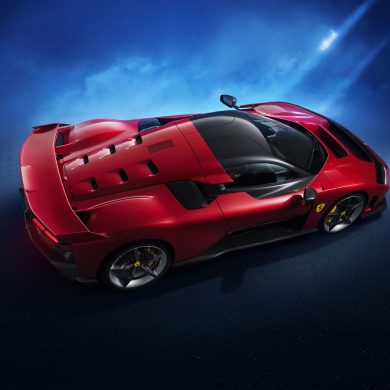
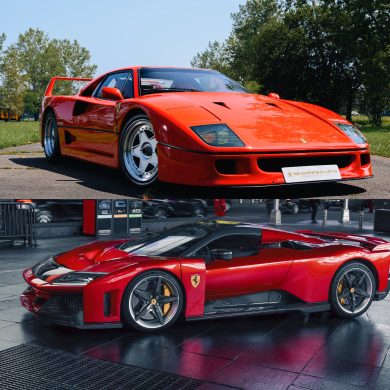
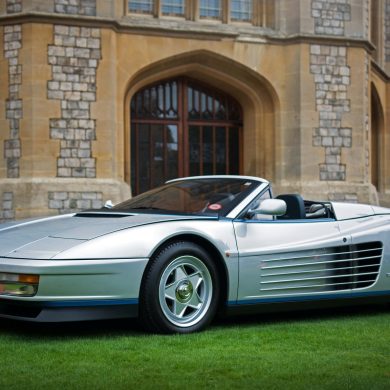
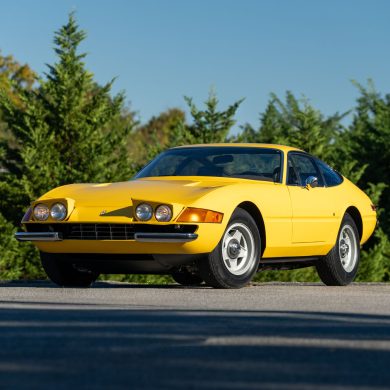
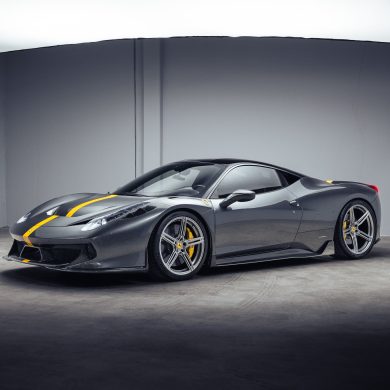


I normally prefer the shape of the SWB Cal Spiders, but this LWB really does it for me. Perhaps I’m blinded by the racing livery, covered headlights and Borranis, but this is an exceptionally smart looking Cal Spider. Serious money, but with it comes an exceptional piece of kit.
I assume that the photos show it present condition. Was the original look restored to the body in 2008?
Just wondering…
I enjoyed the article, however, in the Sebring race recap, the author mentions the car “by daybreak moved toward the head of the pack.” Sebring is a 12-hour race and ends at night, thus “daybreak” is impossible.
Very nice article about the car, but some commentary about the Sebring race is inaccurate. As mentioned in another reply, the race does not go into the morning. In addition, the marker light on the passsenger door was to illuminate the car number so it could be seen by timing and scoring, there were no position lights used in those days.
I was a good friend of Geo. Reed and was part of his entourage at the ’60 Sebring race. I have a photo of this car that I took on pit lane prior to the start of the race that reveals some minor discrepencies in the restoration to ’60 Sebring configuration.